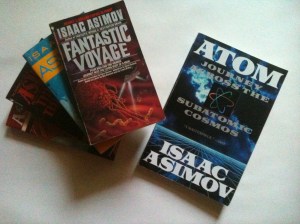If you’re like me, you took some science courses in high school or college because you had to but didn’t learn much. But you like science fiction, or maybe you just like those sciency documentaries on the Discovery Channel, and you feel a little overwhelmed by how complicated science really is. If so, Isaac Asimov’s Atom: Journey Across the Subatomic Cosmos is the book for you.
 Isaac Asimov is better known amongst us Sci Fi folk for writing I, Robot, Fantastic Voyage, and the Foundation novels. But he also wrote many books on science (without fiction). Originally published in 1992, Atom lays out the history of atomic theory starting with the ancient Greeks and quickly moving on to the late 19th and early 20th Centuries, when most of the critical theories about atoms were made.
Isaac Asimov is better known amongst us Sci Fi folk for writing I, Robot, Fantastic Voyage, and the Foundation novels. But he also wrote many books on science (without fiction). Originally published in 1992, Atom lays out the history of atomic theory starting with the ancient Greeks and quickly moving on to the late 19th and early 20th Centuries, when most of the critical theories about atoms were made.
I always like science presented as history because it shows how one discovery leads to another, giving the reader a much clearer understanding of why science is the way it is today. There were two basic discoveries: first, the discovery that matter is made of small, indivisible particles called atoms, and second that those indivisible particles are actually divisible. They’re made of protons and neutrons with a cloud of electrons around them, all held together by tremendous amounts of energy. And those protons and neutrons—they can be broken into smaller particles too, which is where things get weird.
Some of this stuff will seem familiar, coming from half-remembered science classes. Some will be entirely new to you, but Asimov has a way of making complicated concepts easy to understand (even the weirdness). It’s a gift he probably learned writing so many great science fiction stories and novels.
This book gave me a better understanding what atoms are and how they work. Because of Asimov’s clear writing style, it helped me understand the difference between nuclear fission and fusion, why antimatter exists, and what the Pauli exclusion principal is and why it’s important. Understanding atoms makes a lot of things easier to understand; after all, everything is made of them.
One warning: Asimov makes some interesting predictions about future discoveries. For example, he says elements 110 and 114, which had not yet been discovered in 1992, might be stable. They are not. Most of his predictions turned out to be incorrect, so don’t rely on them. Otherwise this is a great way to start the science education you didn’t get in school, and after reading it you’ll find you understand a lot more of what they’re talking about on those sciency Discovery Channel shows.
One thought on “Book Review: Atom: Journey Across the Subatomic Cosmos”